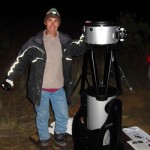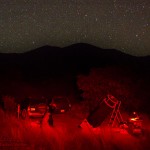Yes, it is three in the afternoon and I am just waking up. That was the plan.
A night spent under dark Mauna Kea skies with a telescope. It has been much too long since I had a good night out with the ‘scope, it was time. A few items conspired to make it happen… Good weather, a note from the HR department that I was at maximum on accumulated vacation time, use it or lose it! Additionally, my friend and co-worker, Olivier Martin, was looking for a night of observing as well.
With a couple days of approved vacation I headed for the mountain.
A partly cloudy sky greeted us on arrival, high and heavy cirrus hid much of the blue. The forecast was for this to clear off during the first part of the night, not yet time to panic. Not wanting to deal with the crowd at the Mauna Kea VIS we hid out in a spot I found on one of the nearby back roads, a place where we would not be disturbed by any visitors through the night, a place that is completely dark.

“Insert screw H into the pre-drilled hole with the included nylon washer” We rummaged through the various bags of hardware looking for nylon washers. It was rather comical, two engineers assembling a 12″ telescope on the side of a mountain. As Olivier observed, we can fix one of the world’s premier AO systems, but can we put together a simple Dobsonian?
In the end the ‘scope did go together properly. Removing the laser collimator form the ‘scope we realized it was time for an age old astronomy tradition. Time for first light!
The target was M42, the Great Orion Nebula, a wonderful field full of nebula greeted our eyes. Better yet, the stars were pinpoints, not smears of light as we feared. The ‘scope appears to have decent optics, and we assembled and collimated it properly. Views of Saturn and Mars at high power confirmed decent optical performance. While a few tweaks and some learning remain, Olivier has a very nice telescope with with to enjoy our dark Mauna Kea skies.
NGC4373 Small, faint, stellar core in a round halo about 2′ across, companion IC3290 is 2′ southwest
IC3290 Small, faint, no structure or core noted, just a 1′ object elongated 2:1 northeast-southwest
NGC4444 Very faint, a patch of haze about 3′ across, no structure, no core noted
M20 A beautiful and complex region of nebulosity that fills the 28′ field of the eyepiece, large, very bright, cut by a pattern of wide dark lanes, the brighter western gegion is roughly circular, separated from the eastern region by a dark lane, the west region divided by three dark lanes radiating from the center, a conspicuous double star at the bright center, the eastern region somewhat dimmer and also showing dark lanes and brighter knots, notable dark void surround the complex

Olivier left about 1am, packing up the new ‘scope, and heading down the mountain. I was not going to give in so easily. With a great sky overhead and my big ‘scope operating perfectly, I kept going ’till dawn.
M30 A curiously irregular globular cluster, oddly asymmetric with two chains of brighter stars emerging from the core to the northwest, about 7′ diameter, bright
NGC7030 Very small, very faint, about 1′ diameter, no core or structure noted
M5 Big, bright, lovely, a coarse appearance with chains of stars sweeping out from a sharp central condensation, fully resolved, about 10′ in diameter, one of the finest globulars in the sky
M4 A large loose globular with a distinctive line of brighter stars runing north-south across the center, a coarse appearance, with chains of stars sweeping out from the center
The arrival of zodiacal light heralded the coming dawn. First Mercury, then a slim crescent Moon rose. When I could not see a fourteenth magnitude galaxy I realized that observing was ending for the night. A few bright globular clusters resisted the growing light, but that was a desperate effort to avoid giving in to the inevitable. A few last looks at Saturn, Mercury and the Moon through the eyepiece, then it was done.
As the Sun returned I put the telescope back in my vehicle and began the drive down. The dawn was spectacular, to an appropriate soundtrack I drove through the beauty, heading for home.

